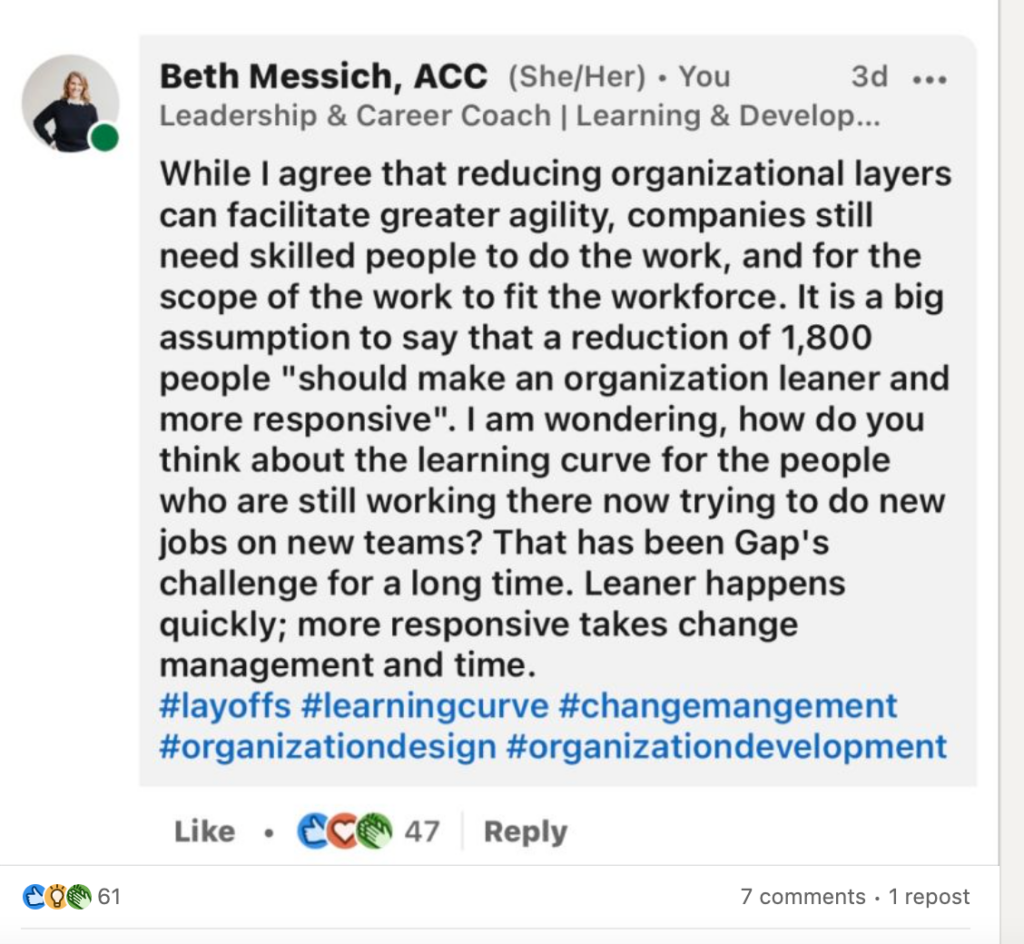I've been managing people and budgets for over 20 years, and I was a CFO in 2008 when the recession hit and we had to drastically cut the company budget. Unfortunately, that included laying off a portion of our team.
Laying off workers is never an easy decision for an organization to make, but, when it becomes necessary, it's important to handle the process compassionately and legally while preserving the employer brand as much as possible.
Here I’ll take you through how you can conduct layoffs the right way, as well as how you can minimize the risk you’ll have to lay anyone off at all.
How to conduct layoffs the right way
Be transparent and respectful
One of the most important things you should do is be transparent with your employees about the situation and provide as much support as possible during the transition.
It's important to communicate clearly and empathetically with employees, expressing gratitude for their contributions and acknowledging the difficulty of the situation.
Ensure that people are made aware of:
- Severance pay
- Benefits (health insurance, leftover, PTO, unused lifestyle spending accounts)
- Career counseling
- Job placement assistance
- Unemployment benefits.
When it comes to creating a communication plan for layoffs, it’s important to involve multiple stakeholders, including HR professionals, legal experts, and senior management.
The plan should be designed to ensure that all employees are notified in a timely and respectful manner and that they have the opportunity to ask questions and receive support during the transition.
Provide them with a clear understanding of the process, including the timeline, the criteria for selecting employees to be laid off, and the reasons behind the decision. Encourage them to ask questions and provide honest answers as much as possible.
By being transparent and supportive, you can help ease the difficult transition of a layoff and help departing employees move on to their next opportunity with dignity.
Unfortunately, in this world of dispersed work, layoffs in-person aren’t always practical. If you’re doing it digitally, ideally it should be conducted face-to-face over Zoom or another communication platform.
Therein lies a caveat—it’s impossible to lay off 1,500 people (or more) via Zoom with a small HR team, especially when it’s something that needs to be done expeditiously. In this case—even though maybe it’s a bit impersonal—it will be an email.
However you do it, what matters most is that you show as much respect and support as possible.
Stripe’s layoff notice is a great example of how to communicate with empathy and transparency.
In their notice, they express gratitude for the contributions of the affected employees and explain the reasoning behind the layoffs in a clear and honest way. They also provide information on severance pay, benefits, and other resources available to help affected employees.
Rely on your human resources team
To ensure legal compliance, trust the expertise of the HR professionals on your team and consider consulting employment attorneys to ensure that the layoff process is handled in accordance with all applicable laws and regulations.
You should also ensure that you’re following your own policies and procedures for layoffs, which may include offering severance pay and continuing benefits. Be sure to clearly communicate those benefits with your employees, too.
Offer outplacement services
As part of the severance package, consider offering outplacement services such as career coaching, resume writing, and job search assistance. These services can be a compassionate and effective way for organziations to support employees during a difficult transition.
Time is of the essence, so providing ample notice and offering job search assistance can help employees feel more secure about their future.
It may also help mitigate some of the negative impacts of a layoff and preserve the company’s reputation and employer brand by demonstrating the company cares about its employees and is willing to invest in their future success.
Be prepared to retrain, rebuild teams, and manage change
When handling layoffs, it’s important to remember it’s not just about cutting costs and reducing headcount.
Companies should also be prepared to retrain and develop existing employees, especially if the need arises to rebuild teams entirely.
By investing in employees’ development and building a culture of continuous learning and growth, you’re equipping your team with the skills they need to adapt to changing business needs.
Leadership and career coach, Beth Messich, makes a good point regarding this on LinkedIn. She raised the point that many people who remain in an organization after a round of layoffs are faced with “new org structures, with new bosses, and in roles with new scopes.”

With so much change happening, the layoff strategy may not always include accounting and planning for training or change management… some of the key pieces needed to achieve the results a company was aiming to achieve through a layoff.
“It requires discipline and consistency, which can often get brushed aside because of other more urgent but not more important matters,” says Messich, “It is not easy, but it is not hard either. And it works better than what many companies are doing now.”
Get feedback from remaining employees on restructuring
Involving your employees in the decision-making process and seeking their input as your company restructures after layoffs will help to identify further inefficiencies and redundancies within the organization that can be addressed before further layoffs become necessary.
It will also foster a greater sense of transparency and trust moving forward. Employee feedback can be obtained through surveys, anonymous suggestion boxes, town hall or “all-hands” meetings, or one-on-one conversations.
It’s important to make sure people feel heard and that their input is taken seriously, as this can help to create a more positive work environment during what can be a challenging time.
How to avoid layoffs
Implement better hiring practices
Of course, the best way to avoid layoffs altogether is to implement better hiring practices and budget accordingly. We saw a lot of overhiring in the last few years, especially at the FAANG companies.
They were overstaffed (even apparently hiring employees to do nothing!) and offered huge compensation packages without considering how sustainable this practice would be. Now the bubble has burst we're seeing headline after headline announcing layoffs at these companies.
Things may have been different if they did a more careful evaluation of staffing needs and took a more strategic approach to workforce planning.
Of course, layoffs may have ultimately been unavoidable but could have been marginal in comparison.
Invest in training and development programs
To avoid layoffs, companies should also consider investing in training and development programs to ensure that people have the skills and knowledge needed to perform their jobs effectively and adapt to changing business needs.
These opportunities allow employees to enhance their skills and knowledge, leading to improved job performance, increased job satisfaction, and potentially higher retention rates.
In addition, employees who receive training and development opportunities are more likely to feel valued by the company and invested in their professional growth.
For the company, investing in training and development programs can lead to a more skilled and adaptable workforce better able to meet changing business needs and drive innovation.
Related read: How To Create A Learning And Development Strategy In 7 Steps
Secondments
Secondments are an option to provide employees with opportunities to learn new skills and gain experiences without having to lay anyone off. It involves temporarily transferring an employee to another department, team, or even a different organization.
For example, Zapier offered a secondment program where employees can work for a different team or in a different role for a set period of time rather than being laid off.
This meant the company didn’t lose loyal and talented individuals and allowed them to gain new skills, expand their knowledge, and potentially discover new areas of interest or career paths.
Additionally, it helps foster collaboration and cross-functional understanding between different parts of the organization.
The Bottom Line on Layoffs
Above all else, if downsizing is necessary and layoffs need to happen, it’s important to prioritize your departing employee’s well-being, remain as transparent as possible, and communicate consistently throughout the process.
Remember, the employees you're letting go are people, often with families to support and bills to pay. This will undoubtedly be a difficult time for them.
Showing laid-off employees empathy, compassion, and respect, and offering as many resources to help them find a new job is just the right thing to do and will protect your reputation moving forward.
Additionally, remaining team members need to be supported and reassured through honest and open communication and a considered approach to restructuring.
Some further resources to help you handle and avoid layoffs:
- 7 Ways To Improve Employee Relations In Your Organization
- How To Create An Efficient, Sustainable Growth Hiring Plan
Join The Conversation
Have any feedback or advice to give on the above?
Leave something in the comments or join us in the People Managing People community, a supportive network of HR and business leaders passionate about building organizations of the future.
To stay up-to-date on important people and culture topics, subscribe to the People Managing People newsletter.

